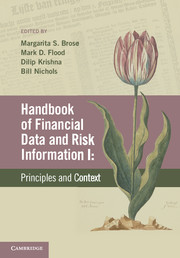PART II - REQUIREMENTS AND SOURCES FOR FINANCIAL RISK MANAGEMENT
Summary
The data environment in the financial industry is expansive, complex, rapidly changing, and riddled with inconsistencies and localized variations. The principal product of the industry being information, data are ubiquitous. Given that financial products are composed of data, the only barriers to manufacturing additional products reside in the ability of the relevant market participants to process that data. Data are not just actively created by every player in the markets, but are also energetically modified across the fabric of the marketplace.
Modifications happen for at least two reasons. Data about transactions are used in calculations to generate new, derived data. Risk and financial management metrics are an example. The derived data are also used to create new, derived transactions which give rise to their own set of data. This second process can be repeated several times to yield a chain of transactions that are linked only by data shared across multiple intermediaries.
The financial industry juxtaposes the real inancial economy with the capital markets. The real financial economy includes retail banking (with products such as credit cards and mortgages), insurance and retail investment products. It also includes the financial activities of large corporations including such activities as hedging financial risks to their operations. Capital markets attempt to combine and make financially fungible these disparate activities. Understanding the intersection of these worlds is critical to analyze the stresses in the marketplace.
- Type
- Chapter
- Information
- Handbook of Financial Data and Risk Information IPrinciples and Context, pp. 175 - 178Publisher: Cambridge University PressPrint publication year: 2014



